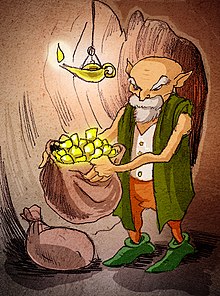Money man
The little money man is a goblin-like creature of the "lower mythology", a house spirit who provides its owner with money. It does not always have the shape of a small male, but can also appear as an animal, such as B. as a toad or frog, or as a bird, such as owl or eagle, occasionally as a worm or beetle. Closely related is the legend of the Drak in the form of a fiery dragon. Similar motifs can be found in the fairy tale of the gold donkey and the fable of the goose that lays golden eggs . The transition to human-like figures, which are made from roots, such as mandrake , and kept in the house for the purpose of increasing money , as well as to the Heckergroschen or Heckertaler , who "hatches" new money, is fluid.
origin
The first mention by name can be found in 1657 in the court files against a Caspar Michel Fuchs from Sulzfeld in the Grabfeld near Meiningen , who was accused of owning a little money man . But even Martin Luther mentioned in his dinner speeches a peasant woman who was suspected of having a Hecker's groschen. It is said that she kept a creature in the form of a black calf hidden in a box in her house, which she fed with boiled milk and breadcrumbs. Luther was extremely hostile to such popular belief and claimed that the creature had in no way brought its owner money, but instead (after being fed incorrectly by a maid) burned the house down. The only purpose of the devil is to deceive the greedy people, to seduce them to sin and to bring them to hell.
to form
The money man was, depending on shape and size, in a box, box or pot, in which money was put in the evening. The next morning you took out the "hatched" money, but never everything, so that the rest could continue to multiply. Like other house spirits, food offerings such as milk, bread or porridge were offered to the money man. If he didn't like the food, he could get angry and take revenge. Unlike goblins, the money men didn't do any work in the house. The owners were also well aware of the Lutheran doctrine of the devilish descent of the money men (hard-working goblins sing in the saga, among other things, spiritual songs to prove their good intentions and their Christian faith). Because of this closeness to the Devil's Pact , many owners of a money man tried to get rid of it after a while. If it was not possible to give it away, then it had to be exorcised with holy water or other sacred objects .
Hans Jakob Christoffel von Grimmelshausen describes in book seven of his main work The adventurous Simplicissimus a spiritus familiaris that brought its owner not only wealth, but also wisdom and power. To get rid of it, you could sell it to someone else, but only for a lower price than you paid yourself. When the price got so low that no one could beat it, the soul of the last owner fell to the devil.
How exactly the increase in money happened was not clear. It was often believed, as in the early modern treasure hunt sagas , that the money available would attract other money. The fiery, dragon-shaped Drak was believed to leave the house at night to steal money elsewhere. Someone who saw him on his way could use magic formulas to get him to drop at least some of his prey. Likewise, the Drak was held responsible for conflagrations in witch trials since around 1500.
See also
literature
- Christa Agnes Tuczay : Ghosts, demons - phantasms. Eine Kulturgeschichte , chapter: Geldmännlein, Fieriger Dragon, Hausschlange und Mandraun , P. 72–78; marixverlag, Wiesbaden 2015; ISBN 978-3-7374-0972-8
- Leander Petzoldt : Small Lexicon of Demons and Elementals , pp. 19–22; Beck'sche Reihe 427, Munich 2003, ISBN 978-3-406-65086-4 .
